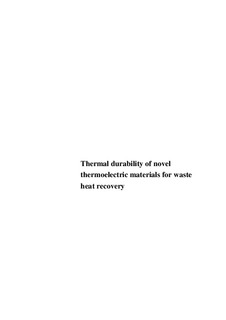| dc.description.abstract | Thermoelectric Generators (TEG) are a potential technology for waste heat recovery. At their hearts, thermoelectric materials convert a heat flux into electric current. By placing TEGs on the surface of a waste heat source, some of the heat can be converted into valuable electric energy. However, todays state-of-the art materials have low efficiencies, are limited to low temperature operation, contains toxic and rare elements and are in general not cost-effective for such applications. New thermoelectric materials are needed that can overcome these barriers.
In this thesis, two classes of materials have been investigated; skutterudites and silicides. Both have relatively high efficiencies, can be used at high temperatures (400-500°C) and contain cheaper and less toxic compounds than state-of-the-art materials. To move these materials from lab-scale testing into real-life applications, the focus is shifted from optimizing for thermoelectric efficiency to long-term stability. As these materials will be used at higher temperatures, different temperature activated processes leading to degradation of the materials needs to be accounted for and controlled, such as oxidation and interdiffusion. Adoption into industrial mass production requires simple and cheap synthesis methods that produces homogenous materials. Homogenous materials are very important for achieving stable thermoelectric and mechanical properties over time.
Secondary phases can easily form during synthesis of skutterudites, and knowledge about the formation and annihilation of such phases during synthesis was therefore studied thoroughly as these can have unbeneficial effect on both thermoelectric properties and thermal durability. Understanding the mechanisms and kinetics governing skutterudite formation is of great importance for optimizing synthesis parameters leading to faster and more homogenous production of skutterudites. P-type skutterudites with composition Fi0.6Co2Fe2Sb12 (Fi = In, Ca, Ce and Yb) were synthesized to look at the effect of filler element and microstructure. Ce-filled sample was furthermore synthesized using four different methods to assess the effect of synthesis method on secondary phase formation and thermoelectric properties. A precursor method was found to not only be the fastest method, but also produce the most homogenous material with highest zT of 0.7. An important contribution of this thesis is the results and discussion around peritectic formation and transformation in the skutterudite system. In addition to grain size, the diffusivity of the filler element in skutterudite was found to be the main factor governing transformation time into phase pure skutterudite.
High temperature oxidation of skutterudites as a function of filler atoms and iron content were furthermore investigated. Residual secondary phases resulting from incomplete transformation into the phase pure skutterudite, such as FeSb2 and CeSb2, were found to have severe effects on the oxidation rate. High iron content was also found to lower the onset temperature of oxidation in accordance with previous studies. In addition, the effect of In as a filler element was found to form an intermediate InSb layer that actually caused a reduction in oxidation rate.
Also the high temperature oxidation of Mg2(Si-Sn) was studied as a function of the Sn content. All these materials formed a passivating outer layer of MgO. Above a certain ignition temperature, the MgO layer broke down and the oxidation proceeded exponentially. An increasing Sn content was found to significantly lower the ignition temperature due to formation of liquid Sn below the MgO layer. Similarly, the Pilling-Bedworth ratio (ratio of volume of oxide to volume of underlying alloy) was found to affect the ignition temperature.
In both these oxidation studies, the common theme is that variations in elemental composition affect the resistance towards oxidation significantly. Clearly, these materials need to be optimized not only in terms of thermoelectric performance, but also stability towards oxidation. First of all, oxidizing resistant materials can be employed in application without the need of protective environments such as coatings or encapsulations. Secondly, control of the oxidation mechanisms is import in a mass production process both to ease the production process and to avoid accumulation of oxides in the final material.
An alternative to oxidation resistant materials is the application of coatings on the outer surfaces. Several commercially available coatings were tested on both skutterudite and silicide. An aluminum-based coating was found most promising and could protect both material classes from oxidation during thermal cycling up to temperatures of 500-550°C. It is believed that further optimization of this type of coating has a good future for use in protection of thermoelectric materials at high temperatures.
To assess how different thermally activated degradation process affect the performance of thermoelectric materials and modules, long term testing of both single functionalized legs and prototype modules were conducted.
A new test method was developed, where several single legs were electrically characterized separately throughout thermal cycling. This made it possible to compare different types of coatings with uncoated material, thereby identify the effect of the degradation processes upon performance. Both diffusion of metal contact into thermoelectric leg, oxidation in from sides, and crack formation, were found to significantly affect the performance of the legs over time, by reducing open circuit voltage and increasing inner resistance.
Finally, several silicide based modules were assembled and tested. The n-type and p-type material was Mg2(Si-Sn) and MnSi1.75 respectively. The highest power of 3 W was measured for one of these modules at hot side temperatures of 700°C and an estimated efficiency of 5.3% – the highest efficiency recorded to date for modules made purely of silicides. However, long term testing of one of these modules revealed gradual reduction in performance. Post-characterization showed how particularly oxidation and interdiffusion between thermoelectric leg and metal contact played a major role in the decline in power output. | nb_NO |

